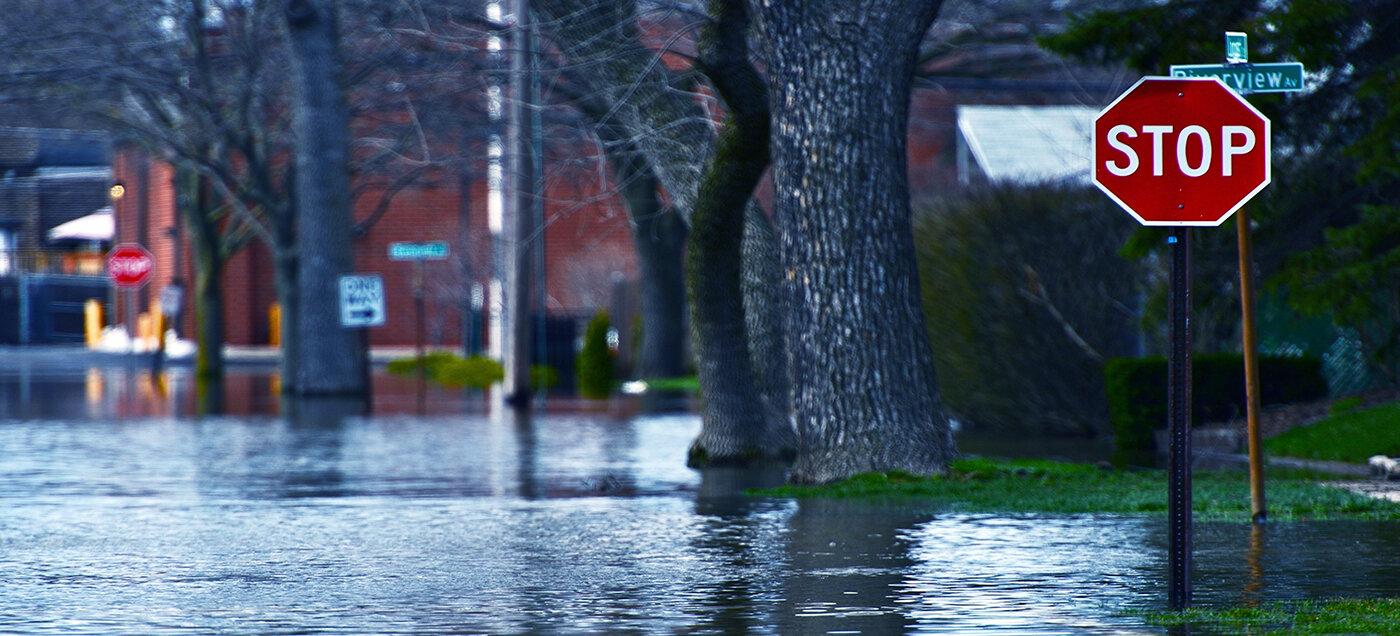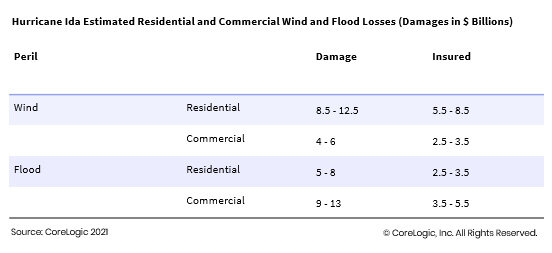Residential Real Estate News

Hurricane Ida Property Damage Could Total $40 Billion
Residential News » New Orleans Edition | By Michael Gerrity | September 2, 2021 9:07 AM ET
According to new data by CoreLogic, insured and uninsured losses from wind, storm surge and inland flooding damages to residential and commercial properties in Louisiana, Mississippi and Alabama are estimated to be between $27 billion and $40 billion.
Total insured flood loss for residential and commercial properties in Louisiana, Mississippi, and Alabama is estimated to be between $6 billion and $9 billion, which includes both storm surge and inland flooding. Uninsured flood loss for this area is estimated to be between $8 billion and $12 billion. Insured wind losses are an estimated additional $8 billion to $12 billion. More than 90% of the losses are estimated to be in Louisiana, primarily in the nine parishes in the New Orleans-Metairie-Hammond metropolitan area and in the Ascension, Lafourche, Livingston and Terrebonne parishes immediately to the west.
Hurricane Ida, the fourth hurricane and second major hurricane of 2021, rapidly intensified into a Category 4 hurricane before making landfall near Port Fourchon on Sunday, August 29, the 16th anniversary of Hurricane Katrina. Much of Louisiana's housing stock was spared from the worst of the initial landfall, as Port Fourchon is a remote area approximately 15 miles southwest of Grand Isle and is known for its significant transport of petroleum. In areas near Hurricane Ida's landfall, destructive winds exceeded 145mph. Substantial damage to property from wind and flooding occurred in the days immediately following the storm.
"Hurricane Ida made landfall less than 40 miles away from where Hurricane Katrina made landfall, but the two storms had substantially different characteristics," said Tom Larsen, principal, insurance solutions at CoreLogic. "Even though Hurricane Ida was a higher wind-speed Category storm at landfall, Hurricane Katrina had a much larger wind field and had spent many hours as a Category 5 hurricane before weakening during its approach to landfall. It brought a much higher storm surge than Hurricane Ida and flooded 80% of New Orleans in addition to devastating the Mississippi coast. With climate change affecting the ocean's temperatures, we should expect to see more frequent and destructive tropical cyclone activity. Homeowners and regional public agency leaders should prepare for more resilient city infrastructure and financial protection from catastrophe."
"While only 40 to 50% of the flood damages from Hurricane Ida appear to be covered by insurance, this is actually an improvement from the uninsured flood damages we saw from Hurricanes Harvey and Katrina," said Larsen. "The flood insurance gap is shrinking."
This analysis includes residential homes and commercial properties, including contents and business interruption and does not include broader economic loss from the storm. The inland flood analysis is based on the rainfall for 48 hours ending at 6 a.m. CDT on August 31, 2021.
The remnants of Ida made their way into the Tennessee Valley last night, an area still recovering from the unexpected and catastrophic flash flood that swept through Waverly on August 21. This area is expected to see additional flooding in the coming day(s). Areas with already saturated ground should exercise caution as rain continues through the week, as ground erosion like the devastating highway collapse in Lucedale, Mississippi is possible.

Sign Up Free | The WPJ Weekly Newsletter
Relevant real estate news.
Actionable market intelligence.
Right to your inbox every week.
Real Estate Listings Showcase
Related News Stories
Residential Real Estate Headlines
- Las Vegas Area Home Prices Uptick 4.3 Percent Annually in March
- Single-Family Rent Growth in U.S. Trends Upward in 2025
- U.S. Mortgage Rates Tick Down Post Trump Tariffs Commencement
- President Trump's 'Liberation Day' Tariffs Potential Impact on the U.S. Housing and Mortgage Markets
- Baby Boomers Biggest Cohort of U.S. Home Buyers in 2025 as Millennials Decline
- U.S. Monthly Housing Payments Hit Record High in 2025
- U.S. Pending Home Sales Uptick in February
- Global Prime Residential Rent Slowdown Continued in Late 2024
- Ireland Home Price Inflation Hits 8 Year High in Early 2025
- Existing Home Sales in America Uptick in February
- Great Miami Area Residential Sales Decline 15 Percent Annually in February
- Mortgage Rates Uptick in Mid-March, Ending 9-Week Decline in U.S.
- World Property Ventures Builds the Future of Real Estate with New Funding Round
- U.S. Builder Sentiment Declines Amid Economic Uncertainty and Rising Costs
- Black Homeownership Rates in U.S. Enjoy Largest Annual Increase of All Racial Groups
- Wealthy Renters Are Taking Over More of the U.S. Rental Market
- If U.S. Congress Does Not Extend NFIP Soon, Thousands of Daily Home Closings Impacted
- U.S. Mortgage Applications Spike 11 Percent in Early March
- Greater Palm Beach Area Residential Sales Rise in Early 2025
- New Apartments in U.S. Are Leasing at Slowest Pace on Record
- U.S. Mortgage Rates Drop to 4 Month Low in March
- Overall U.S. Mortgage Delinquency Rates Dip in December
- New Tariffs on Canada, Mexico to Impact U.S. Homebuilder Input Costs
- Monaco's Property Market: A Tale of Two Cities
- U.S. Home Purchase Cancellations Surge, 1 in 7 Sales Getting Canceled
- U.S. Pending Home Sales Hit Historic Low in Early 2025
- Greater Miami Area Residential Sales Dip in January
- Governor DeSantis Supports Ending Property Taxes in Florida
- WPV Aims to Become the Berkshire Hathaway of Real Estate Tech
- U.S. Home Sales Slump Continues in January
- Average Americans Spend 38 Percent of Monthly Income on Mortgage Payments
- Switzerland's Safe-Haven Appeal Grows with World's Wealthy Homebuyers
- U.S. Builder Confidence Rapidly Declines in February
- Las Vegas Home Sales Rise 6.7 Percent Annually in January, Condo Sales Dip
- Homebuyer Demand in America Drops to 5-Year Low in Early 2025
- Ownership More Affordable Than Renting in Most U.S. Markets
- The World's First Global Listings Service Launches, Called a GLS
- Home Prices Continue to Rise in 89 Percent of U.S. Metros in Late 2024
- Global Luxury Residential Prices Showed Gradual Improvement in Late 2024
- U.S. Construction Hiring Rate Drops to Lowest Levels in 5 Years





